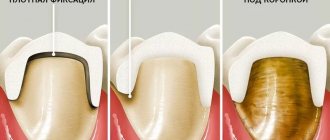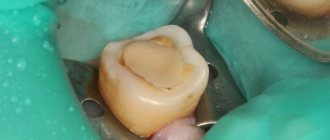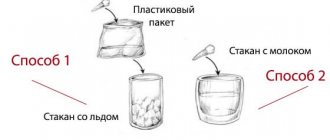Concept and signs of a dead tooth
As long as the nerves in the tooth are functioning, it is not considered “dead”
A tooth in which the nerve has stopped functioning or has been completely removed is considered dead.
It received this name due to the fact that after depulpation it ceases to receive nutrients and is also completely deprived of pain.
If the depulpation procedure was carried out efficiently, then such a tooth will hold quite firmly in the gums, and the enamel will not allow it to crumble. However, because the nerve has been removed, the dead tooth cannot receive the required amount of nutrients, so it begins to take on a grayish tint.
Procedure technology
The depulpation procedure can be carried out in three ways:
- vital extirpation – removal of the pulp occurs completely and is carried out under local anesthesia. The procedure involves removing the nerve in just one session, but requires careful examination;
- Devital amputation is the use of a special drug to mummify part of the nerve. It involves applying a special paste that leads to pulp necrosis. This technique is used extremely rarely, since it can cause a number of complications associated with necrotic processes in the nerves. Can only be found in low-budget dental offices;
- diathermy - necrosis of the nerve occurs by applying a current discharge, after which the dead nerve is removed. An electrode is inserted into the pulp area, passing a current through itself, which not only kills the nerve, but also cauterizes the wound.
After the depulpation procedure, you may experience pain for several days that occurs when you squeeze your jaw or eat hot or cold food (drinks). This pain does not require treatment and goes away on its own. Read more about why a tooth hurts after nerve removal in this article.
Signs
If you heard a “dead tooth” from a doctor, then this name means that such a tooth has lost living tissue. Accordingly, only enamel and dentin remained from it. You can recognize it by the following signs:
- After you have undergone depulpation, the tooth becomes slightly grayish. However, in the future it will acquire a darker shade.
- The tooth stops reacting to everything cold and hot
- If a tooth is affected by caries, then there will be no pain even if something sweet gets into the damaged part of it.
- Slowly the tooth, which has acquired grayish and darker shades, begins to decay
What is pulp?
The pulp is defined as a bundle of nerve endings and vascular connections. Better known among patients as the dental nerve. Thanks to this part of the structure, the tooth remains alive and is able to respond to external stimuli. If the dental shell is damaged, there is a high probability of severe pain. If an inflammatory process of the pulp is diagnosed, then the moment of tooth extraction cannot be ruled out (to preserve it, the nerve is removed). Depulpation is a last resort if drug treatment is not able to solve the problem.
Indications for nerve removal:
- After the prosthetic procedure, the patient experiences hypersensitivity.
- When the pulp has been damaged due to exposure to a toxic substance or a strong antiseptic.
- The development of a dental cyst was diagnosed.
- Ineffective treatment of caries lesions, pulpitis.
- A chip or other damage that led to the opening of the nerve ending.
- Prosthetic replacement of a dental element that is subject to severe caries or grows at an incorrect angle.
Note! The first symptoms that indicate the development of an inflammatory process of the pulp are a discomfort when eating certain foods, for example, sweet, sour, or when eating too hot or cold food. The pain syndrome can radiate to the temporal region, ear, and neck.
How long can a tooth be useful after depulpation?
As a rule, it is unusual for a tooth to be dead. The problem is not only the change in its color, but also its gradual destruction.
If the filling is placed poorly. Such a tooth can live for two to three years maximum, and in rare cases six or seven. However, if a tooth is filled by a highly qualified dentist, it can last more than ten years.
If the tooth has already begun to decay, then you should not be afraid of this either. A specialist will be able to put a crown on it that will serve you for many years.
What is pulp
Pulp is a fibrous, loose connective tissue located in the dental cavity. It is penetrated by many lymphatic and blood vessels and nerve endings. Thanks to the pulp, that is, the nerve, the tooth is alive and reacts to any external irritants.
If the tooth shell is damaged, sharp, persistent pain may occur. If an inflammatory process of the pulp tissues is detected, the doctor will suggest that the patient undergo depulpation, that is, remove all of his living tissues. This option is a last resort measure, which is carried out if the preparation of a tooth damaged by caries or other diseases does not produce results.
Blackening of the tooth after nerve removal
Darkening of a dead tooth is almost inevitable.
It is common for a dead tooth to change its color to dark gray, as nutrients stop getting into it.
There are several reasons why tooth surface discoloration occurs:
- After depulpation, the blood supply to the dead tooth is significantly reduced. It receives a certain amount of nutrients from nearby tissues, but this is absolutely not enough for that. To maintain its original whiteness
- If you visited the dentist and he removed your nerve poorly, this may also be one of the reasons why the tooth color began to change. As a rule, an insufficiently qualified doctor after depulpation may not completely remove nerve particles or bacteria may enter the wound, which affect the color of the tooth.
- It is worth examining one case that is not the most popular, but still, it can also cause darkening of the tooth. If the dentist used materials that contain silver or resorcinol-formaldehyde when filling, then the tooth may acquire not only a grayish tint, but also become pink. However, in modern medicine, materials containing these components are rarely used
What to do with a dead tooth
If the nerve is not completely dead, inflammation may appear, and if the teeth are dead, they may crack or cause aesthetic discomfort by darkening the enamel. They need to be treated, because ignoring them can lead to inflammation, which causes cysts to appear, and they can only be treated with surgery.
Lifespan of a dead tooth
After removal of the nerve and proper treatment, chewing functions may be preserved. The lifespan of a tooth may depend on the following factors:
- Be careful (do not chew hard food).
- Quality and methods of treatment.
- Care (oral hygiene and visiting the dentist every six months).
Treatment of pulpitis is an endodontic treatment in which the pulp is removed, the root canals are mechanically cleaned and disinfected, and a filling is placed. Also, to extend the service life, special orthopedic crowns are installed (protective caps that evenly distribute the chewing load and protect against chipping).
In case of poor-quality root canal treatment, it is difficult to determine the service life, since some complications are possible (flux, fistula on the gum, pain after filling the canals, cyst).
Dead tooth hurts, what to do
Even if there is no living nerve inside the canal and it is sealed, the nerve endings may remain in the surrounding tissue and pain may be felt. There are several causes of pain:
- infection;
- ligaments may hurt from overstrain under increased load, for example, from a high filling;
- poor quality treatment (part of the pulp remained in the canal);
- allergy to filling;
- pain in neighboring teeth radiates to death;
- inflammation of the maxillary sinus can cause pain.
Pain syndrome may appear immediately after removal of the nerve, when anesthesia ends. You need to take painkillers.
If a few days after removal of the dental nerve the pain intensifies, swelling and an unpleasant odor appear, you need to consult a dentist. If you are allergic to a filling, the doctor must put in a new one (from a different material).
How to fight
Unfortunately, you will not be able to completely whiten your teeth to their original state at home. The change in color does not lie in the enamel, but in internal processes that are associated with a lack of nutrients. Below are several ways to combat the darkening of a dead tooth:
In-canal whitening
In-canal whitening is considered one of the most popular
This method is considered one of the most popular. Whitening is carried out not outside, but inside the tooth itself.
- First, the dentist removes the filling and all filling material from the root canals.
- After all the filling material has been cleaned, a special gel with hydrogen peroxide is poured into the tooth itself, which promotes whitening.
- When the procedure is completed, a temporary filling is inserted into the tooth, usually for two weeks.
- If the tooth begins to darken more within two weeks, the patient must visit his dentist again and carry out the whitening procedure again. It can be done two to four times
- If the whitening is completely completed, the tooth is filled with a permanent filling.
Important! Please note that this whitening method is prohibited for children and pregnant women. Also, people whose teeth suffer from excessive sensitivity or those who are allergic to hydrogen peroxide should not resort to it.
Installation of veneers
This method is considered more reliable than the previous one. Veneers are transparent plates that are attached to the teeth, due to which they cover dark spots and all irregularities. As a rule, the material for their manufacture is ceramics or zirconium dioxide.
Another advantage of veneers is that they can hide minor tooth defects.
Installing veneers is another way to whiten teeth, although not cheap.
The cost of veneers is quite considerable (starting from twenty thousand for one piece). However, they are installed for the entire time the tooth lives. If it is completely destroyed, then this method is definitely not suitable for you.
Prosthetics
Installing crowns is considered the most radical method of all of the above. It can be installed even on a completely darkened and decayed tooth.
Before performing prosthetics, the dentist grinds and grinds the dead tooth so that in the future the crown will fit much more tightly to it. Then the doctor makes a cast from plaster, thanks to which individual prostheses will be made.
The crown is a special cap made of ceramic, cermet or zirconium dioxide. Thanks to it, you can completely cover the dead tooth and restore your smile to its beautiful appearance. In addition, this method has another advantage, which is that the tooth will be preserved under the crown, and its tissues will deteriorate much more slowly.
If we talk about metal-ceramic crowns, they are used quite rarely by those people who want to return the former aesthetics to their smile. The problem is that such a crown itself has a dull grayish tint.
Most often, patients choose ceramic crowns or those made of zirconium, since they have a color close to the natural color of the teeth.
This method is considered quite expensive, and if your goal is to achieve the most natural color of your teeth, then you will have to carry out this procedure over several visits to the dentist.
In order to prevent darkening of teeth, you should follow some rules:
- Periodic visits to your dentist
- Pay attention to what kind of brush and toothpaste you use. For dead teeth, it is best to use a toothpaste that contains a small amount of fluoride
- Be sure to brush your teeth thoroughly twice a day
- Don't forget to change your brush at least once every four months
- After eating, you should resort to using special dental floss or toothpicks.
- When brushing your teeth, do not forget to brush the surface of your tongue.
Foods high in calcium will help a dead tooth last longer.
If you have dead teeth, then you also need to watch your diet. Try to include as many foods as possible that contain large amounts of calcium.
Pulp
If the plexus is inflamed, it may be necessary to completely remove the process. Depulpation is a painful procedure, and it is used only when it is impossible to solve the problem with the diseased appendage in other ways.
Indications for pulp removal:
- When it is damaged as a result of exposure to a strong antiseptic or toxic drug.
- When it is impossible to place a crown on a patient because he has increased sensitivity.
- Poor treatment of caries.
- The appearance of a cyst.
- When a shoot grows in the wrong direction.
- Chipped enamel that exposes the pulp.
The first symptoms that indicate the need to remove the nerve are pain when eating. The sensations can be transmitted to other areas - temple, ear.
Treatment
It is important a dying or dead tooth promptly . This is because left untreated, bacteria from a dead tooth can spread and lead to the loss of other teeth. It can also affect your jaw and gums.
Your doctor may urgently treat a dead or dying tooth with a procedure known as a root canal.
Root canal
With a root canal, you can keep your tooth intact. During the procedure, the dentist makes a hole in the tooth and then uses small instruments to remove the pulp and clear the infection. Once all the infection has been removed, your dentist will fill and seal the canals.
In many cases, you may need a crown after a root canal. This may be a good option if the enamel has been damaged. Over time, a tooth that has had a root canal can become brittle. This is why crowns are usually recommended for back teeth. A crown is a covering that is specially molded to fit your tooth. The doctor will save a portion of your existing tooth and then place a crown over the tooth. The crown can be made to match the color of your surrounding teeth so that it is not noticeable.
If your doctor says you don't need a crown, you can use teeth whitening.
Dental treatment prices









